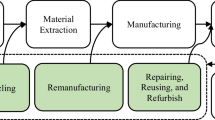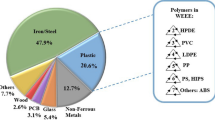Abstract
Labels are used for marketing, technical information, local of production and environmental declarations of products. The aim of the study was to evaluate the life cycle of two sets of front and back adhesive labels made with different liners: polyethylene terephthalate (PET) and glassine paper. The study is a pioneering initiative in the labelling industry using life cycle assessment, especially in Brazil. The attributional life cycle assessment method was based on the ISO 14044 standard and covered the entire life cycle, cradle to grave. Primary data for key suppliers, printing facility and label use composed the foreground data, while the ecoinvent database composed the background data. The material efficiency was assessed through mass balance. The impact assessment methods were cumulative energy demand for non-renewable energy and ILCD 2011 midpoint for the environmental categories. The glassine liner is heavier than the PET which resulted in larger environmental indicator values for production, transportation and waste treatment. On the other hand, energy demand of label set with glassine liner was lower than the PET. Furthermore, the hotspot analysis of each impact category was presented per process and substance. The label set made with glassine liner tended to present larger environmental indicator values in most categories, 13 of the 16 assessed, compared to the label set made with PET liner, despite the uncertainties. Contribution analysis identified that the pre-manufacturing step presented larger environmental indicator values than manufacturing, use and post-use steps along the label set life cycle. Therefore, environmental improvement opportunities were evaluated through scenarios of end of life, recycled inputs, domestic suppliers, waste prevention and product redesign. Moreover, the life cycle assessment was useful for diagnosing the energy and environmental profiles of self-adhesive labels and planning cleaner production measures that avoid environmental tradeoffs.







Similar content being viewed by others
Notes
Matrix is the remaining face material withdrawn after the surface half-cut in the form of labels.
References
ABIGRAF (Associação Brasileira da Indústria Gráfica) (2012) 16° Anuário Brasileiro da Indústria Gráfica. ABIGRAF, São Paulo
ABIGRAF (Associação Brasileira da Indústria Gráfica) (2017) Números da Indústria Gráfica Brasileira. Departamento de Estudos Econômicos – Decon/ABIGRAF Nacional, São Paulo
ABRE (Associação Brasileira de Embalagem) (2011) Protocolo Global sobre Sustentabilidade de Embalagens 2.0. ABRE, São Paulo
Baccini P, Brunner PH (2012) Metabolism of anthroposphere: analysis, evaluation, design. MIT Press, Cambridge
Barbosa DO, Wittmann GCP, Luz MCPN (2009) Guia Técnico Ambiental da Indústria Gráfica. CETESB and Sindigraf, São Paulo
Bousquin J, Gambeta E, Esterman M, Rothenberg S (2012) Life cycle assessment in the print industry. J Ind Ecol 16(S1):S95–S205
Castillo LG, Leão LC (2014) Criação de diretrizes para a avaliação do desempeno ambiental da indústria gráfica. In: Blucher Design Proceedings (ed) 11° Congresso Brasileiro de Pesquisa e Desenvolvimento em Design. Blucher, São Paulo, pp 1–13
Cencic O, Rechberger H (2008) Material flow analysis with software STAN. J Environ Eng Manage 18(1):3–7
Coustillas J, Gaasbeek A, Vieira M (2016) LCA of a polypropylene self-adhesive label—FINAT & TLMI case study. PRé Consultants, Amersfoort
EC (European Commission) (2012) Characterisation factors of the ILCD recommended life cycle impact assessment methods. Publications Office of the European Union, Luxembourg
Fairley M, Jerschefske D, Quirk J, Thomaz A (2014) Environmental performance and sustainable labeling—become a ‘greener’ label converter and user. Tarsus Exhibitions & Publishing Ltd, London
Fiksel J (1996) Design for environment: creating eco-efficient products and processes. McGraw – Hill, New York
Frischknecht R, Wyss F, Büsser-Knöpfel S, Lützkendorf T, Balouktsi M (2015) Cumulative energy demand in LCA: the energy harvested approach. Int J Life Cycle Assess 20:957–969
Gaasbeek A, Vieira M, Coustillas J (2016) LCA of a paper self-adhesive label—FINAT & TLMI case study. PRé Consultants, Amersfoort
Ghisellini P, Cialani C, Ulgiati S (2016) A review on circular economy: the expected transition to a balanced interplay of environmental and economic systems. J Clean Prod 114:11–32
Ghose A, Chinga-Carrasco G (2013) Environmental aspects of Norwegian production of pulp fibres and printing paper. J Clean Prod 57:293–301
Goedkoop M, Oele M, Leijting J, Ponsioen T, Meijer E (2016) Introduction to LCA with SimaPro. PRé, Amersfoort
Hansuebsai A (2011) Moving forward of Thai printing industry to environmental issue. J Print Sci Technol 48(1):11–16
Heijungs R, Suh S, Kleijn R (2005) Numerical approaches to life cycle interpretation—the case of the Ecoinvent’96 database. Int J Life Cycle Assess 10(2):103–112
Iokibe T (2014) Evaluation of carbon offsets and carbon footprint through environmental assessment of waterless printing. J Print Sci Technol 51(6):410–413
IPCC (Intergovernmental Panel on Climate Change) (2013) Climate change: the physical science basis. Cambridge University Press, Cambridge and New York
ISO (International Organization for Standardization) 14044 (2006) Environmental management—life cycle assessment—requirements and guidelines. ISO, Geneve
Jungbluth N, Frischknecht R (2010) Part II: 2. Cumulative energy demand. In: Hischier R, Weidema B, Althaus H-J, Bauer C, Doka G, Dones R, Frischknecht R, Hellweg S, Humbert S, Jungbluth N, Köllner T, Loerincik Y, Margni M, Nemecek T (eds) Implementation of life cycle impact assessment methods. Ecoinvent report no 3 v2.2, Dübendorf, pp 33–40
Kiurski J, Marić B, Adamović D, Mihailović A, Grujić S, Oros I, Krstić J (2012) Register of hazardous materials in printing industry as a tool for sustainable development management. Renew Sust Energ Rev 16:660–667
Kiurski J, Marić B, Aksentijević S, Oros I, Kecić V, Kovacˇević I (2013) Indoor air quality investigation from screen printing industry. Renew Sust Energ Rev 28:224–231
Kiurski J, Marić B, Oros I, Kecić V (2017) The ecodesign practice in Serbian printing industry. J Clean Prod 149:1200–1209
Matsumoto T, Tabata H (2014) Environmental impact assessment of waterless printing and conventional printing: evaluation with an environmental analysis tool. J Print Sci Technol 51(6):414–418
Matuchevski K (2007) Desempenho ambiental: estudo de caso em uma indústria gráfica. Dissertation, Universidade Federal de Santa Maria
Moger TE (2006) An environmental review of the printing industry. Earth Environ 2:343–381
Moreno-Ruiz E, Weidema BP, Bauer C, Nemecek T, Vadenbo CO, Treyer K, Wernet G (2013) Documentation of changes implemented in ecoinvent database 3.0. ed. ecoinvent report no 5, St. Gallen
Pré (2016) Life cycle assessment for the self-adhesive label: guidance document. Tag and Label Manufacturers Institute Inc. - TLMI and Féderation INternationale des fabricants et transformateurs d'Adhésifs et Thermocollants - FINAT, Gloucester and The Hague
Rossi M, Germani M, Zamagni A (2016) Review of ecodesign methods and tools. Barriers and strategies for an effective implementation in industrial companies. J Clean Prod 129:361–373
Shimizu H, Nagata K (2010) Integrated life cycle assessment (LCA) approach for printing service by using environmental load point (ELP) method. J Print Sci Technol 47(3):177–185
Shimizu H, Nagata K, Hansuebsai A (2012) Comparison of corporative allocation methods and product cumulative methods for printing service life cycle assessment (LCA). J print Sci Technol 49(4):263–271
Silva DAL, Delai I, Castro MAS, Ometto AR (2013) Quality tools applied to cleaner production programs: a first approach toward a new methodology. J Clean Prod 47:174–187
Silva DAL, Oliveira JA, Saavedra YMB, Ometto AR, Pons JR, Durany XG (2015) Combined MFA and LCA approach to evaluate the metabolism of service polygons: a case study on a university campus. Resour Conserv Recycl 94:157–168
Sonnemann G, Tsang M, Castells F, Schuhmacher M (2004) Integrated life-cycle and risk assessment for industrial processes. Lewis Publishers, London
Wang J, Hou C, Lin P (2013) Two-phase assessment for the environmental impacts from offset lithographic printing on color-box packaging. J Clean Prod 53:129–137
Wernet G, Bauer C, Steubing B, Reinhard J, Moreno-Ruiz E, Weidema B (2016) The ecoinvent database version 3 (part I): overview and methodology. Int J Life Cycle Assess 21:1218–1230
Yue W, Cai Y, Rong Q, Cao L, Wang X (2014) A hybrid MCDA-LCA approach for assessing carbon foot-prints and environmental impacts of China’s paper producing industry and printing services. Environ Syst Res 3(4):1–9
Funding
The project was sponsored by National Service of Industrial Learning (SENAI) at National Department (SENAI-DN) and Santa Catarina (SENAI-SC), Baumgarten Gráfica Ltda., the Brazilian National Council for Scientific and Technological Development (CNPq) and Coordination for the Improvement of Higher Education Personnel (CAPES) - Finance Code 001.
Author information
Authors and Affiliations
Corresponding author
Ethics declarations
Conflict of interest
The authors declare that they have no conflict of interest.
Additional information
Responsible editor: Philippe Loubet
Publisher’s note
Springer Nature remains neutral with regard to jurisdictional claims in published maps and institutional affiliations.
Electronic supplementary material
ESM 1
(DOC 3700 kb)
Rights and permissions
About this article
Cite this article
Medeiros, D.L., Braghirolli, F.L., Ramlow, H. et al. Environmental improvement in the printing industry: the case study of self-adhesive labels. Environ Sci Pollut Res 26, 13195–13209 (2019). https://doi.org/10.1007/s11356-019-04460-3
Received:
Accepted:
Published:
Issue Date:
DOI: https://doi.org/10.1007/s11356-019-04460-3




